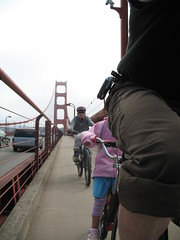 My children and I cross the Golden Gate Bridge bicycle path. When counts were last done in 2002, 1600 bicyclists daily rode across on weekdays. Anecdotally, bicycle use has climbed significantly since then. The Golden Gate Bridge and other similar bicycling facilities in the San Francisco Bay Area are a vital part of the transportation network for bicyclists.
My children and I cross the Golden Gate Bridge bicycle path. When counts were last done in 2002, 1600 bicyclists daily rode across on weekdays. Anecdotally, bicycle use has climbed significantly since then. The Golden Gate Bridge and other similar bicycling facilities in the San Francisco Bay Area are a vital part of the transportation network for bicyclists. Last night on PBS News Hour with Jim Leher, U.S. Transportation Secretary Mary Peters explained the Bush Administration’s policy of no new taxes to fund repairs for the transportation infrastructure. Peters told News Hour that up to 20 percent of the federal gasoline tax is earmarked for non-transportation projects, specifically mentioning bicycling facilities as an example of inappropriate, non-transportation use of the federal gasoline tax.
The League of American Bicyclists responded with a letter to Peters correcting some of the impressions made by Ms. Peters:
- That bicycle facilities are not transportation related. “Tens of millions of bicyclists and pedestrians in communities across the country use trails to get to work, school, shops, and to visit friends and family,” writes LAB Executive Director Andy Clarke. “Every one of these trips prevents congestion, pollution, and energy consumption while improving the health of the rider or walker.”
- “You left the impression that an enormous percentage of Federal transportation funds are spent on projects such as these. The reality is that only one percent of these funds are spent on bicycling and walking projects despite the fact that these two modes account for ten percent of all trips in the country and 12 percent of traffic fatalities each year.”
Clarke urges Peters to stand by a statement she made at the 2002 Washington, DC bike summit, where Peters said, “Many people in our country use bikes for more than recreation. For them, bikes are their vehicle for the commute to work and for the errands of daily life. We need every mode of transportation to keep America mobile. What modes did you use to get to your hotel? Very few of us depend on a single mode. I strongly agree with Secretary Mineta, bicyclists are an integral part of our nation’s transportation system and we all need to work together to develop a better more balanced transportation system that provides facilities and programs for bicyclists on a routine basis.”
The LAB also asks cyclists to send their comments to Ms. Peters to share their personal viewpoints.
In the News Hour interview, Peters also praised New York City’s proposed congestion pricing. “I think it’s a great idea,” said Peters. “Commuters today are paying. They’re paying with their time. They’re paying with their productivity. They’re sitting stuck in traffic in New York City and other cities in the United States today. So they’re paying. If this congestion process gives them the ability to get out of being stuck in traffic, to make the air cleaner, to use less fuel, to create a better environment in their city, I think it’s a great idea.”
Elsewhere:
- BikePortland: Bike paths are not transportation infrastructure.
- Malcom X Park: Bicycles as transportation.
- Philadelphia Bicycle News: Bicyling is not transportation.
- Bike Lawyer: Take action now.